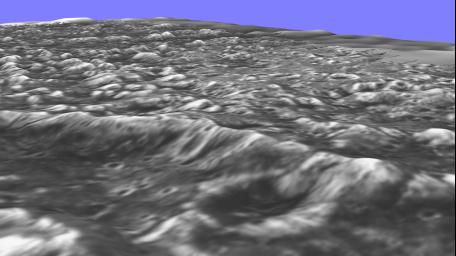
Galileo Regio, Ganymede, proposed site for WorldCon in 2110.
Computer-generated image produced by the Jet Propulsion Laboratory from multiple surface images taken by the Galileo Spacecraft.


Power to the habitat will be supplied by a network of sattelites orbiting within Jupiter's Van Allen radiation belts. These satellites will convert free-electron radiation directly to electricity and then send this power via microwave transmission to the habitat.
Although recent discoveries of a magnetosphere around Ganymede encourage us that extraordinary radiation shielding will be unnecessary, a magnetic field generation system will be installed to shield the entire habitat from radiation generated by more unusual phenomina, such as solar flares and meteor strikes. This will be powered by a separate nuclear reactor, which will also serve as the habitat's secondary power supply. Each dome of the habitat will also be covered in solar panels on the triangular surfaces of the geodesic form, as a tertiary power source, and to keep water and air recycling facilities operating in each dome in the event of an emergency.
Construction will be acheived using nanotechnological construction robots. Programed with the planned schematics of the habitat, these microscopic robots will be transported to Ganymede well in advance of the convention aboard multiple small disposable spacecraft loaded with unrecyclable refuse excavated from Earth's landfills. This garbage will be soft-landed at Galileo Regio, at which point the nanorobotic workers will disassemble, molecule by molecule, the ship, refuse, and ultimately many of their own number, reassembling the molecules in new elemental forms in construction of the habitat.
With expected advances in propulsion, including fusion reactors and further developments in ion engines, we anticipate travel times between Earth and Ganymede to be down to a reasonable three months each way. Look at this as an opportunity to have a convention en route to the convention, and get to know some of your fellow con goers in one of the numerous small-crew and passenger complement vessels.